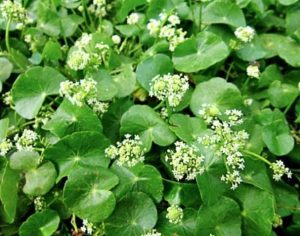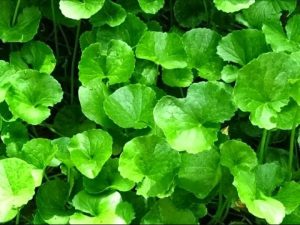BOTANICAL NAME: Centella asiatica
FAMILY: Umbelliferae
CLASSICAL CLASSIFICATION:
Charaka: Vayasthapana, Tikta skandha, Prajasthapana
Sushruta: Tikta varga
ENGLISH NAME: Indian Pennywort
COMMON NAME:
Punjabi– Brahmi
Hindi– Brahma Manduki, Brahmi
Kannada– Ondelaga, Brahmi soppu
Bengali– Jholkhuri, Thalkuri, Thankuni


REFERENCE: BHAVAPRAKASH SAMHITA with link e Nighantu:
https://niimh.nic.in/ebooks/e-Nighantu/bhavaprakashanighantu/?mod=read
मण्डूकपर्णी- (गुडूच्यादि वर्ग)
मण्डूकपर्णी माण्डूकी त्वाष्ट्री दिव्या महौषधी |
ब्राह्मी हिमा सरा तिक्ता लघुर्मेध्या च शीतला |
कषाया मधुरा स्वादुपाकायुष्या रसायनी ||२३६||
स्वर्या स्मृतिप्रदा कुष्ठपाण्डुमेहास्रकासजित् |
विषशोथज्वरहरी तद्वन्मण्डूकपर्णिनी ||२३७||
HABITAT: commonly found as a weed in crop fields and other waste places throughout India up to an altitude of 600 m.
BOTANICAL DESCRIPTION:
The Small creeping herb with slender stem. The leaves are about 1 to 3 from each node, orbicular-reniform, crenate, base cordate, petioles channeled with adnate stipules. The flowers are fascicled umbels each carrying 3 or 4 flowers, short stalked. The fruits are Cremo carp, ovoid, with laterally compressed seeds.
AYURVEDIC CHARACTERISTICS:
| RASA | GUNA | VEERYA | VIPAKA | PRABHAVA | DOSHGHNTA |
| Tikta | Laghu | Șita | Madhura | Medhya | Kapha-pitta șámak |
AYURVEDIC ENERGETICS:
| TASTE | PROPERTY | POTENCY | POST DIGESTIVE EFFECT | EFFECT ACTION | DOSHA ACTION |
| Bitter | Light | Cooling | Sweet | Memory enhancer | Kapha and pitta pacifying |
MAJOR CHEMICAL CONSTITUENTS: Hydrocotyline, Asiaticoside, valerine, sterols, glycosides.
THERAPEUTIC USES:
- Kamala: Mandukaparni juice is mixed with honey, haridra, amalaki or milk are taken in morning.
- Pitika: Application of mandukaparni juice locally will be useful.
- Unmada: juice of mandukaparni, Dhattura leaves and Somavalli shall be given.
INDICATIONS:
Atisara Diarrhea, Jwara Pyrexia, Unmada Psychotic disorders, Chittodvega Anxiety
USEFUL PART: whole plant
DOSAGE: 3 – 6 gm
AYURVEDIC FORMULATION:
1. Brahma Rasáyana
2. Mandukaparni Rasayana
